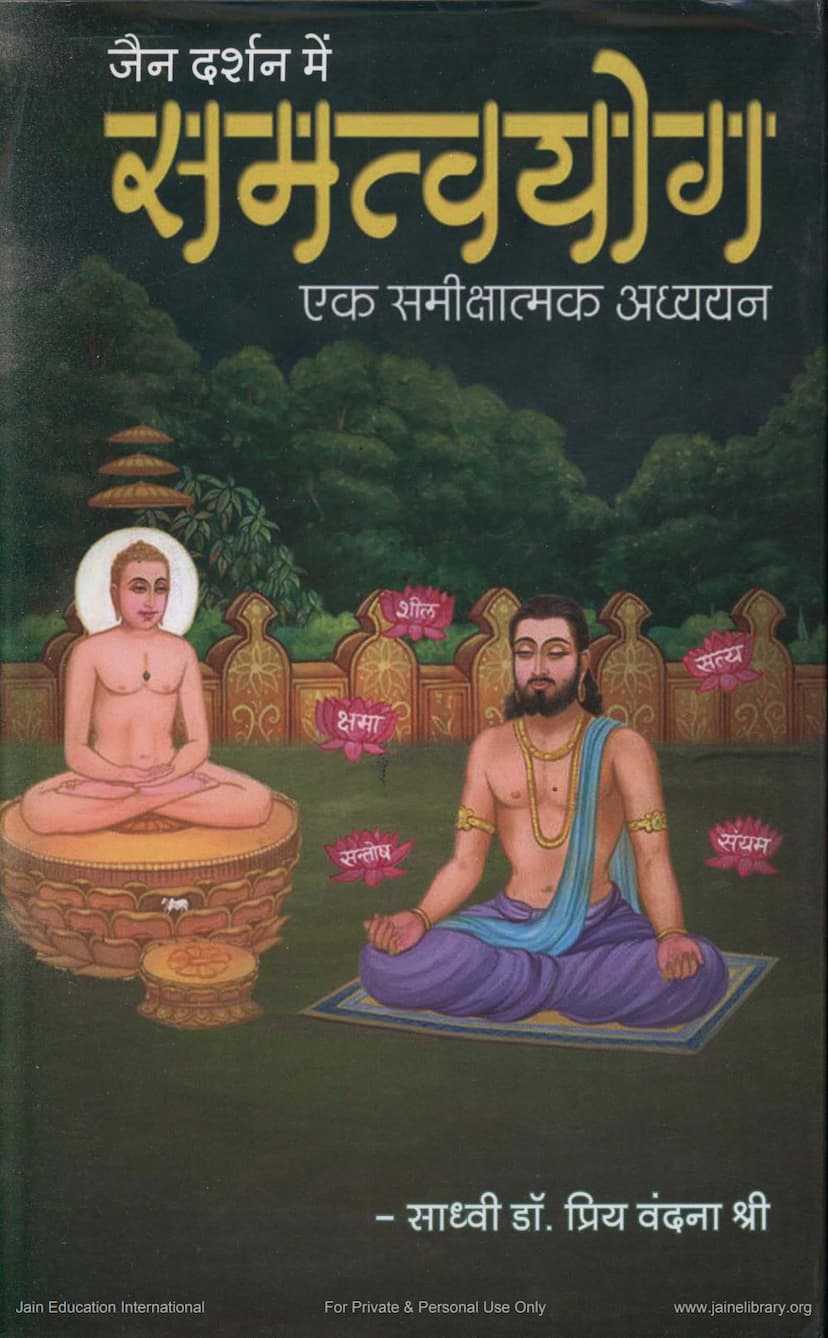Jain Darshan Me Samatvayog
Added to library: September 1, 2025

Summary
Here's a comprehensive summary of the Jain text "Jain Darshan me Samatvayog" by Sadhvi Dr. Priyavandanashreeji, based on the provided pages:
Title: Jain Darshan me Samatvayog: Ek Sameekshatmak Adhyayan (Samattva Yoga in Jain Philosophy: A Critical Study)
Author: Sadhvi Dr. Priyavandanashreeji
Publisher: Prem Suchan Prakashan, Peddtumbalam AP
Overall Purpose: This book is a doctoral dissertation (Ph.D.) submitted to Jain Vishva Bharati Institute, Ladnun. It critically examines the concept of Samatva Yoga (Yoga of Equanimity) within the framework of Jain philosophy.
Core Theme: The central theme of the book is the profound significance and practice of Samatva Yoga or Samata (equanimity) in Jainism. It argues that Samatva Yoga is not just a philosophical concept but the very essence of Jain spiritual practice, leading to liberation.
Key Concepts and Arguments:
- Samatva as the Essence of Jainism: The book posits that Samatva Yoga (also referred to as Samabhava, Samata, or Samayika in Jain texts) is the core principle of Jain spiritual discipline. It is presented as the ultimate goal and the path to liberation (Moksha). The author highlights that this equanimity is the inherent nature of the soul (Atma) which gets obscured by passions (Kashayas).
- Samatva Yoga and Samayika: The text draws a strong parallel between Samatva Yoga and Samayika, a fundamental Jain religious practice. Samayika is described as the practice of achieving equanimity, which involves controlling the mind, speech, and actions, and being detached from worldly pursuits.
- The Tripartite Path of Liberation (Moksha Marga): Jainism outlines a path to liberation through Samyak Darshan (Right Faith/Perception), Samyak Gyan (Right Knowledge), and Samyak Charitra (Right Conduct). The book extensively explores how Samatva Yoga is intrinsically linked to and underlies all three aspects:
- Samyak Darshan: Right faith is presented as the foundation for Samatva Yoga, emphasizing unwavering conviction in the true nature of reality and the path to liberation. It is described as an unshakeable dedication to Vitaragta (non-attachment) and Samata.
- Samyak Gyan: Right knowledge, particularly the discernment between the soul (Atma) and the non-soul (Anatma), is crucial for shedding attachment. This understanding helps in achieving detachment from worldly pleasures and pains, which is essential for equanimity.
- Samyak Charitra: Right conduct, described as the practical manifestation of right faith and knowledge, is where Samatva Yoga is actively lived. The five great vows (Mahavratas) and other disciplines of conduct are seen as ways to cultivate equanimity.
- The Role of Kashayas: The book identifies passions like anger, pride, deceit, and greed (Kashayas) as the primary impediments to achieving Samatva. The entire spiritual journey is depicted as a process of overcoming these passions to reach the state of equanimity.
- Stages of Spiritual Development (Gunasthanas): The 14 Gunasthanas (stages of spiritual development) are analyzed in the context of Samatva Yoga. The journey from Mithyatva (delusion) through various stages to Ksheen Moh (eradication of passions) and finally to the pure states of Sayogi Kevi and Ayogi Kevi (liberated souls) is presented as a progression towards greater equanimity. The lower stages are characterized by Asamatva (lack of equanimity), while the higher stages represent the increasing mastery of Samatva.
- Comparison with Other Philosophies: The book undertakes a comparative study of Samatva Yoga with concepts in Upanishads, the Bhagavad Gita, and Buddhist philosophy. It highlights the common ground in the pursuit of equanimity, detachment, and inner peace across these traditions while emphasizing the unique Jain perspective.
- Psychological and Social Relevance: The book also delves into the modern psychological understanding of stress, anxiety, and mental well-being. It connects the ancient Jain principles of Samatva Yoga to contemporary psychological needs, arguing that equanimity is a potent tool for stress management, emotional regulation, and achieving inner peace in today's world. Furthermore, it discusses the importance of Samatva in fostering social harmony, resolving conflicts, and promoting ethical conduct in personal and social life.
- The Four Guṇabhāvanās (Virtuous Dispositions): The text also elaborates on the four important ethical dispositions (Bhāvanās) for cultivating equanimity:
- Maitri (Friendliness): Cultivating a feeling of friendship towards all beings.
- Pramod (Appreciative Joy): Rejoicing in the virtues and well-being of others.
- Karuna (Compassion): Feeling compassion for those who are suffering and striving to alleviate their pain.
- Madhyastha (Equanimity/Impartiality): Maintaining a balanced attitude towards all, regardless of their actions or our experiences with them.
- The Role of Practices: The book details various Jain practices that aid in the cultivation of Samatva, such as Samayika itself, meditation (Dhyana), vows (Vratas), austerities (Tapas), reflection on the 12 reflections (Anuprekshas), and the importance of the Six Essential Duties (Shadaavashyak).
Structure of the Book (as indicated by the table of contents):
The book is structured into several chapters that systematically explore Samatva Yoga:
- Chapter 1: The Place of Samatva Yoga in Jain Sadhana.
- Chapter 2: The Tripartite Path of Jain Sadhana and Samatva Yoga.
- Chapter 3: Samatva Yoga: The Seeker, the Goal, and the Path.
- Chapter 4: Personal and Social Sadhana of Samata.
- Chapter 5: Comparative Study of Samatva Yoga.
- Chapter 6: Modern Psychology and Samatva Yoga.
- Chapter 7: Conclusion.
Overall Message: The book powerfully conveys that Samatva Yoga is not merely an abstract concept but a practical philosophy that offers a profound solution to the psychological and social problems of human existence, leading ultimately to spiritual liberation. It emphasizes the universal applicability of this Jain teaching, advocating for its integration into personal and societal life for achieving lasting peace and well-being.